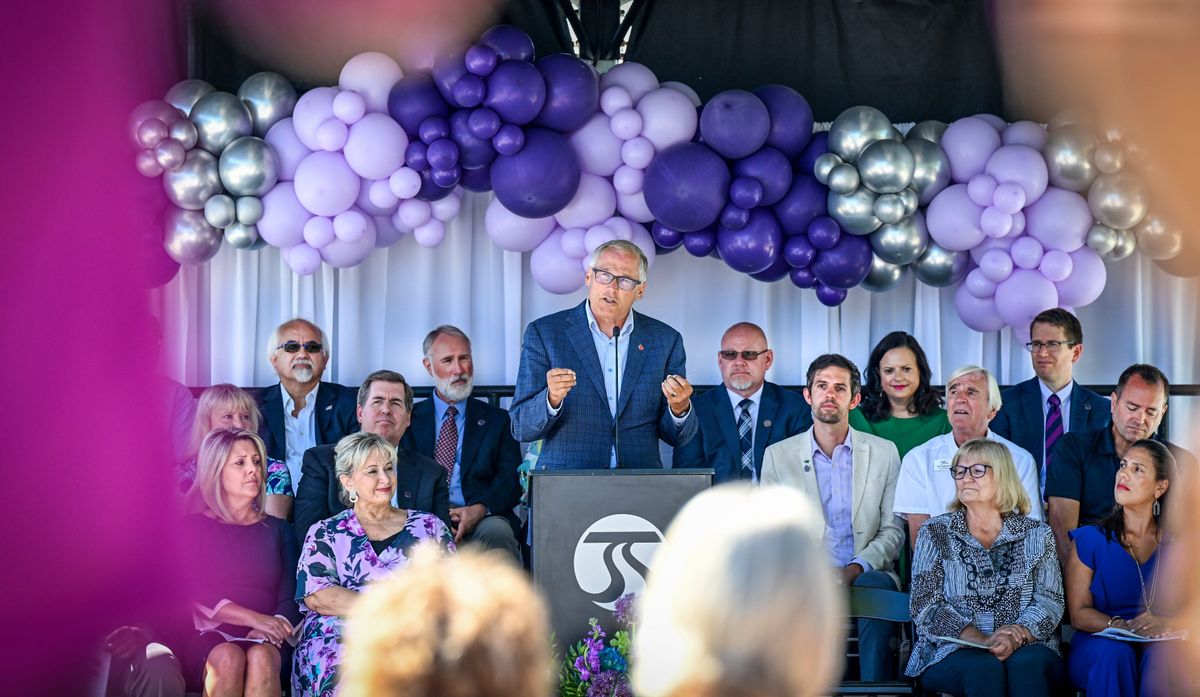Inslee, Woodward and others celebrate launch of City Line, Spokane’s first rapid bus route

Gov. Jay Inslee and Mayor Nadine Woodward gathered on the Gonzaga University campus Tuesday with local, state and federal officials to celebrate the launch of the all-electric City Line, Spokane’s first rapid transit bus route.
The governor connected climate-related disasters across the globe, the rising risk of wildfires in the American West and the increased pollution of wildfire smoke in the country’s air with the need for mass transit such as the new bus initiative.
“I asked myself, where is the state that can attack this problem?” Inslee said. “Where is the city that will stand up to decarbonize our transportation system so we can attack climate change?”
“The answer, I am proud to say, is Washington state, and it is Spokane this morning,” he added.
Veronica Vanterpool, deputy administrator for the Federal Transit Administration, congratulated Spokane for the launch of its first rapid bus route and highlighted the work of her agency to modernize the country’s transit system.
“All across the country, bus rapid routes like the City Line are changing how we commute, how we live, how we engage, how we recreate, providing safe, frequent and reliable transit,” Vanterpool said.
Vanterpool joined other local officials to celebrate the City Line for coming in under budget, noting how expensive transit systems could be.
Though there are some relatively small costs outstanding, the City Line is expected to end up costing around $82 million , about $10 million under budget. While initial estimates in 2014 predicted the route would cost around $72 million, the Spokane Transit Authority budgeted the project at more than $92 million in 2019 when the agency began applying for federal grants, STA spokeswoman Carly Cortright said.
The 6-mile route stretches between Browne’s Addition and Spokane Community College and began service Saturday, the long-awaited launch punctuated by five block parties in neighborhoods along the route .
“I got to attend the celebration at Chief Garry, and you could really feel the excitement,” said Spokane Mayor Nadine Woodward . “It is the result of exceptional teamwork, from public agencies, private contractors and community volunteers. The city is proud to be a part of the team from the very beginning of the journey that got us here today.”
Nearly 4,500 people rode the 60-foot, battery-electric City Line buses during the first day of operations. The route will be free to passengers through Labor Day while riders familiarize themselves with the system.
The agency could not immediately provide full ridership numbers for the following two days because of difficulties collecting data from one of the buses, Cortright said.
The rapid transit system isn’t as rapid yet as originally planned: Driver shortages mean the City Line will reach a given stop every 15 minutes for 17 hours a day, six days a week, with a 30-minute service on Sunday. Staffing is expected to be at full capacity no later than May 2024, at which point the stops will be serviced by a bus every 7 ½ minutes during peak hours and every 10 minutes between 9 a.m. to 3 p.m.
The transit signal priority system, which signals to upcoming traffic lights to turn green ahead of the arrival of a City Line bus, is not yet fully implemented, Cortright said. The city has been slow to implement the system , including at some intersections such as Cincinnati Street and Mission Avenue that can hamper the City Line’s ability to keep to a tight schedule during heavy traffic, Cortright said.
Local leaders are looking to future expansions of a modern transit system in the city. Where the City Line runs east and west, the next stage of rapid transit is likely to be located on North Division Street, connecting downtown Spokane with communities on the northern edge of the city and county.